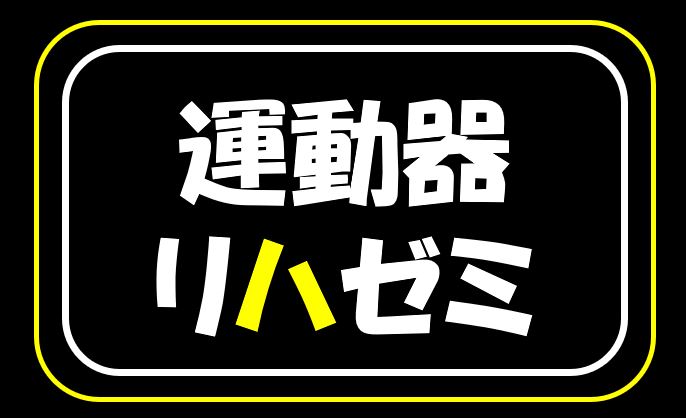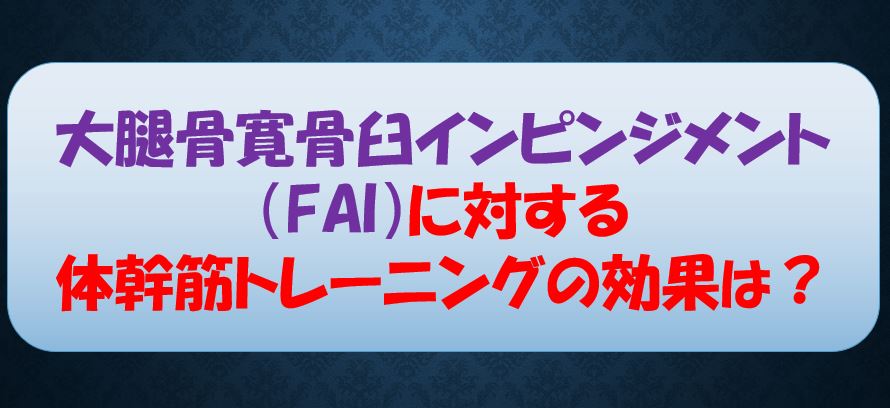こんにちは!
運動器専門のリハビリスタッフです!!
いつもお世話になります。
今回は、『大腿骨寛骨臼インピンジメント(FAI)に対する体幹筋トレーニングの効果は?』について解説させていただきます。
大腿骨寛骨臼インピンジメントは医療業界では(FAI:Femoro Acetabular Impingement)と称され『FAI』と呼ばれることが多いです。
症状としては、鼠径部や大腿外側の動作時痛、股関節の引っかかり感などがあり、階段昇降や長時間の歩行での痛みが特徴とされています。
FAIは股関節の屈曲・内転・内旋動作や深屈曲で骨盤と大腿骨が衝突して、関節唇や関節軟骨に損傷が生じる疾患とされています。
比較的、活動性が高くスポーツをしている若年者に多い傾向にあります。
診断はレントゲン、CT、MRIなどの画像検査にて確認します。
治療としては、保存療法(薬物療法、運動療法)や手術療法(関節唇縫合、骨棘切除、THAなど)などがあります。
◆FAIのタイプ分類
FAIの分類は大きく分けて3つ
1、CAM(キャム) タイプ
大腿骨の骨頭から頚部への移行部が骨性膨隆により、くびれがなくなる。
20~30代男性に多くみられる。
2、Pincer(ピンサー) タイプ
寛骨臼前外側に過度の骨性被覆が生じる。
30~40歳代の女性に多くみられる。
寛骨臼に骨棘や形態以上があると過剰に大腿骨頭を覆うためインピンジメントが生じる
3、Mixed タイプ
CAMタイプとPincerタイプの両方を併発
そんな中、2019年に、FAIに対する体幹筋トレーニングの効果検証した論文が海外で報告されております。
この論文の検証結果が気になるところです。
◆論文紹介
Randomized Controlled Trial
Clin J Sport Med (IF: 3.64; Q2)
. 2019 Jul;29(4):267-275.
doi: 10.1097/JSM.0000000000000516.
A Prospective, Randomized, Controlled Trial Comparing Conservative Treatment With Trunk Stabilization Exercise to Standard Hip Muscle Exercise for Treating Femoroacetabular Impingement: A Pilot Study
大腿骨臼蓋インピンジメント治療のための体幹安定化エクササイズによる保存的治療と標準的な股関節筋エクササイズを比較した前向き無作為化対照試験(A Prospective, Randomized, Controlled Trial): パイロットスタディ
Michihisa Aoyama 1, Yasuo Ohnishi 2, Hajime Utsunomiya 2, Shiho Kanezaki 2, Hiroki Takeuchi 1, Makoto Watanuki 1, Dean K Matsuda 3, Soshi Uchida 2
Affiliations expand
PMID: 31241527 PMCID: PMC6613832 DOI: 10.1097/JSM.0000000000000516
Abstract
Objective: To assess the efficacy of conservative management of women with femoroacetabular impingement (FAI) using trunk stabilization.
要旨
目的 大腿骨肩甲骨インピンジメント(FAI)を有する女性に対し、体幹安定化運動を用いた保存的管理の有効性を評価すること。
Design: Randomized controlled trial (level of evidence: I).
デザイン 無作為化比較試験(エビデンスレベル:I)。
Subjects: Twenty FAI female patients who met the inclusion FAI criteria.
対象者 対象FAI基準を満たした女性FAI患者20名。
Methods: A prospective, randomized, controlled study was performed on 20 female patients with symptomatic FAI comprising 2 groups (10 hips in trunk stabilization exercise group vs 10 hips in control group). We evaluated hip range of motion, isometric muscle strength using a handheld dynamometer (μ-TasMF-01; Anima, Co), and patient-reported outcome measures, including modified Harris hip score, Vail hip score, and international hip outcome tool 12 (iHOT12) before and at 4 weeks and 8 weeks after the intervention.
方法 症候性FAIの女性患者20名を対象に、2群(体幹安定化運動群10脚 vs 対照群10脚)から成る前向き無作為化対照試験を実施した。股関節可動域、携帯型ダイナモメーター(μ-TasMF-01;Anima社製)を用いた等尺性筋力、および患者報告式のアウトカム指標(modified Harris hip score、Vail hip score、international hip outcome tool 12(iHOT12)など)を介入前、介入後4週、8週で評価した。
Results: There was a significant improvement in the range of motion of hip flexion in the trunk training group detected as early as 4 weeks after the intervention compared with the control group (P < 0.05). Hip abductor strength significantly improved in the trunk training group at 4 weeks after the intervention, whereas it did not improve in the control group (P < 0.05). Vail hip score and iHOT12 were significantly increased at 8 weeks after the intervention in the trunk training group compared with the control group (iHOT12: 78.7 ± 22.4 vs 53.0 ± 22.3; P < 0.01, Vail hip score: 81.6 ± 18.5 vs 61.1 ± 11.6; P < 0.05). There was no significant difference in the modified Harris hip score between both the groups at 4 and 8 weeks after the intervention.
結果 体幹安定化運動群では、対照群に比べ、介入後4週間という早い段階で股関節屈曲可動域の有意な改善が認められた(P < 0.05)。股関節外転筋力は、介入後4週目に体幹安定化運動群で有意に改善したのに対し、対照群では改善しなかった(P < 0.05)。Vail hip scoreとiHOT12は、介入後8週目に、体幹安定化運動群で対照群と比較して有意に増加した(iHOT12: 78.7 ± 22.4 vs 53.0 ± 22.3; P < 0.01, Vail hip score: 81.6 ± 18.5 vs 61.1 ± 11.6; P < 0.05).介入後4週間および8週間におけるmodified Harris hip scoreは両群間に有意差はなかった。
◆論文の結論
Conclusions: The addition of trunk stabilization exercise to a typical hip rehabilitation protocol improves short-term clinical outcomes and may augment nonoperative and postoperative rehabilitation.
結論 一般的な股関節リハビリテーションのプロトコルに体幹安定化運動を加えることで、短期的な臨床結果が改善し、術前・術後のリハビリテーションを補強できる可能性がある。
◆まとめ
上記論文では女性FAI患者20名を体幹安定化運動群10脚と対照群10脚に分けて、股関節可動域、等尺性筋力、股関節スコア(modified Harris hip score、Vail hip score、international hip outcome tool 12(iHOT12)など)を介入前、介入後4週、8週で評価しております。
結果としては、体幹安定化運動群では、対照群に比べ、介入後4週間という早い段階で股関節屈曲可動域と股関節外転筋力が有意な改善しております。
Vail hip scoreとiHOT12は、介入後8週目に、体幹安定化運動群で対照群と比較して有意に増加したとのことです。
介入後4週間および8週間におけるmodified Harris hip scoreは両群間に有意差はなかったそうです。
以上のことから、FAIに対して、一般的な股関節のリハビリテーションに加え、体幹安定化運動を追加することで関節可動域や筋力等、股関節機能が改善される可能性があることが示されています。
今回は、『大腿骨寛骨臼インピンジメント(FAI)に対する体幹筋トレーニングの効果は?』について解説させていただきました。



